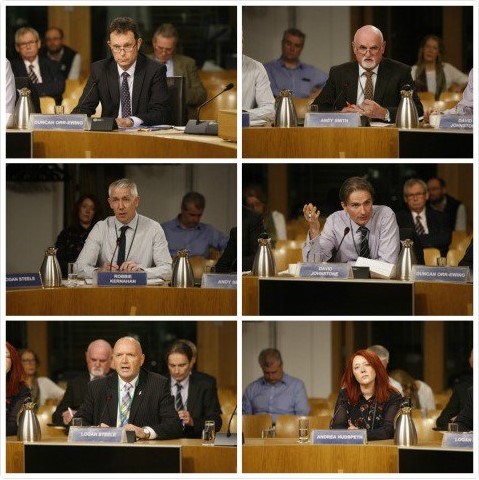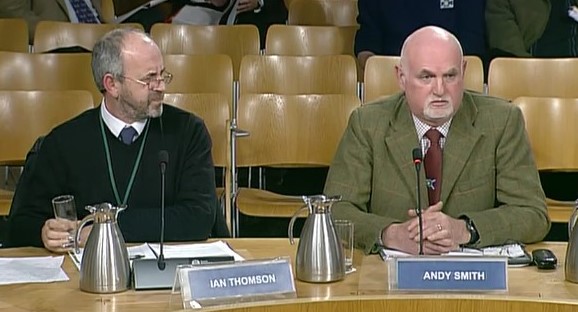Another week and another duplicitous article from Tim (Kim) Baynes, Director of SLE’s Scottish Moorland Group. This guy seems to live in a perpetual state of denial when it comes to the illegal persecution of raptors on driven grouse moors.
This time he’s penned an article for the latest edition of Shooting Times about the ridiculous Heads Up for Hen Harriers project (more on this below).
The front cover of the Shooting Times has a headline banner: “The hen harrier: how much do we really know?”, which laughably infers that the cause of long-term hen harrier decline in the UK is still a bit of a mystery that needs solving, and then inside there’s a two-page spread from Tim (Kim) who suggests that ‘weather’ and fox predation are the big culprits, as recorded by Heads Up for Hen Harrier cameras. Astonishingly, he also claims that the illegal persecution of hen harriers on grouse moors is an “historical controversy”.
You can read the full article here: Shooting Times 7 June 2017_HaveYouSeenAHenHarrier_TimBaynes

Perhaps he missed the Government-commissioned 2011 Hen Harrier Conservation Framework, which set out very clearly what the main issue is: Illegal persecution is the biggest single factor affecting hen harriers and it is having a dramatic impact on the population, not only in northern England but also in Scotland:
- The potential national hen harrier population in Scotland is estimated (conservatively) to be within the range 1467-1790 pairs.
- The current national hen harrier population in Scotland as recorded during the 2010 national survey is 505 pairs, more than a 20% decline from the numbers recorded during the 2004 national survey.
- In Scotland, the hen harrier has a favourable conservation status in only five of 20 regions.
- Two main constraints were identified: illegal persecution, and in one region, prey shortages.
- The species is particularly unsuccessful in the Central Highlands, Cairngorm Massif, Northeast Glens, Western Southern Uplands and the Border Hills. There is strong evidence in these grouse moor regions that illegal persecution is causing the failure of a majority of breeding attempts.
Tim (Kim) also appears to have missed the video published by RSPB Scotland last month showing exactly what happens when a camera is installed at a hen harrier nest without the grouse moor owner and gamekeeper’s knowledge:
He must also have missed last month’s news that Police Scotland are investigating the illegal shooting of yet another hen harrier on a grouse moor near Leadhills (see here), which incidentally is alleged to have happened on the estate owned by the Hopetoun family – that’ll be the family of Lord Hopetoun, Chair of the Scottish Moorland Group, of which Tim (Kim) is, er, Director.
The only ‘historical’ aspect of hen harrier persecution is that it’s been going on for over a hundred years. Pretending that it’s now stopped, in the face of such overwhelming evidence to the contrary, is the response of an idiot.
We’ve blogged about the Heads Up for Hen Harriers project many times (e.g. see here, here, here). The idea is that estates give permission for cameras to be installed at active hen harrier nests ‘to help build a picture of why these birds aren’t doing as well as they should be’. The major flaw in this ‘study’ design is that gamekeepers will know on which nests the cameras are pointing, so obviously they’re not going to shoot the adults or stamp on the eggs/nestlings at those sites. Instead, the cameras will record natural failures (e.g. poor weather, predation) and then the grouse shooting industry can use this information to claim that illegal persecution isn’t an issue, but poor weather and predation is. This is exactly what Tim (Kim) Baynes has done in this latest article.
Now, some might argue that having grouse moor owners’ agreement to install cameras at hen harrier nests on their estates is a good thing – at least those nests will be left alone and the birds might be able to produce some young. There is that, of course. But leaving the birds alone long enough to produce fledglings isn’t enough. What happens to those young fledglings once they leave the safety of a monitored nest? You only have to look at what happened to young hen harrier Elwood to answer that question. He survived for approximately two weeks after dispersing from his monitored nest site before un-mysteriously vanishing on a grouse moor in the Monadhliaths – funnily enough in an area where many satellite tagged golden eagles have also un-mysteriously vanished.
Tim (Kim) talks about the number of estates that have agreed to participate this year (at least 15) and makes much of the fact that some of these are grouse moor estates. The same thing happened last year, although what was covered up last year was the fact that only three nests were successful and none of those was on a driven grouse moor. This wasn’t a surprise given that most of the driven grouse moor estates that agreed to ‘participate’ were located in the Angus Glens – an area that hasn’t seen a successful hen harrier breeding attempt since 2006.
What would be more interesting to know is not how many estates have agreed to ‘participate’, which is a largely meaningless figure unless they actually have an active nest, but how many estates have refused to participate? Again, this information is not made public, presumably because it’ll spoil the image of this so-called ‘widespread cooperation’ from grouse moor estates.
We’ve got another question for Tim (Kim). In this article he says:
“A better idea of current numbers will emerge when the results of the 2016 UK harrier population survey are published, but the overall picture is expected to be broadly the same in Scotland“.
Really? On what basis is he making this claim? The results of the National HH Survey have not yet been released (held back, we believe, due to the General Election, but due out shortly), so what makes Tim (Kim) think that “the overall picture is expected to be broadly the same in Scotland”? Is this based on factual information or is Tim (Kim) just making up some nonsense to suit his agenda?
It’s not like he/Scottish Moorland Group/Gift of Grouse hasn’t done this before (e.g. see here, here, here).








 The
The 

 Last week, Environment Cabinet Secretary Roseanna Cunningham gave a speech at the Scottish Raptor Study Group’s annual conference, where she described, with feeling, her ‘contempt‘ for the continued illegal persecution of birds of prey (see
Last week, Environment Cabinet Secretary Roseanna Cunningham gave a speech at the Scottish Raptor Study Group’s annual conference, where she described, with feeling, her ‘contempt‘ for the continued illegal persecution of birds of prey (see  Alex Hogg, Chairman of the Scottish Gamekeepers’ Association, has a long track record of talking out of his backside.
Alex Hogg, Chairman of the Scottish Gamekeepers’ Association, has a long track record of talking out of his backside.
 The data in the above table were derived from the 2003 national golden eagle survey. Since then, a 2015 national survey has been undertaken and we await publication of the detailed results, although the preliminary findings have shown that there have been
The data in the above table were derived from the 2003 national golden eagle survey. Since then, a 2015 national survey has been undertaken and we await publication of the detailed results, although the preliminary findings have shown that there have been